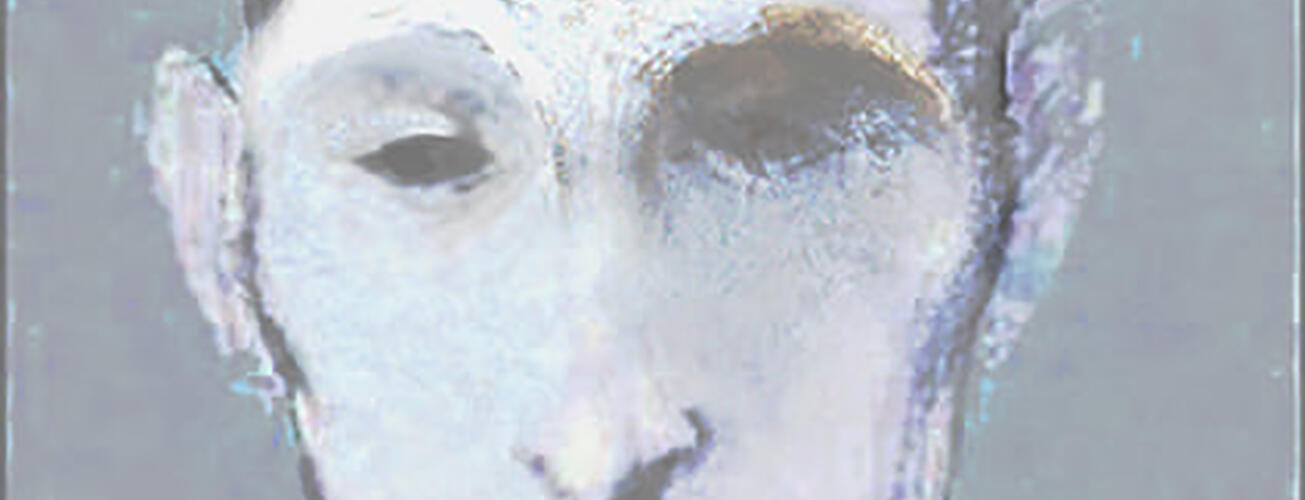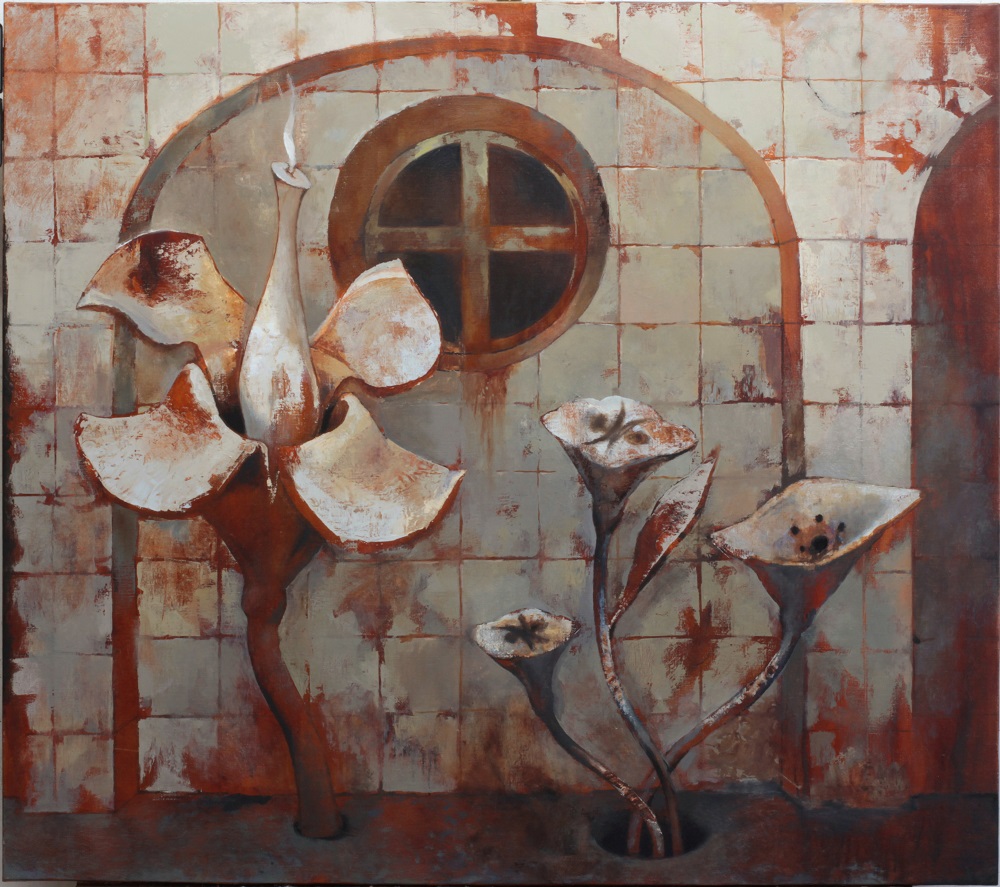The artist asserts that this entire series is about solitude and mourning: as if people thrown out onto the street, worn-out parts are separated from the grand mechanism and become unnecessary. At the same time, they appear both humanely unhappy and mechanistically dreadful, merging human and mechanical aspects in forms that are quite enigmatic. Time has dismantled crucial connections, gnawed at fragments, and transformed these mechanisms into mysterious, unusual, and irrational objects that have acquired almost human fractures and breaks. They have become objects of creative play and further transformations of childhood impressions, which serve as the starting point of the artist's imagination.

VIRTUAL EXHIBITION
The artist Ivan Semiletov uses painting as a means of capturing unnamed feelings, as a way to preserve what quickly appears and disappears in a moment. Hence, the characteristic method of creating paintings - subtle coloristic construction, flickering surfaces, conscious breaks in the drawing, which sometimes imitates surrealist writing in an attempt to outline the silhouettes of unreal entities. Surfaces of embodied objects become a rich source of imagery, containing folds, fractures, hints, thus creating a parallel and independent narrative on the border between figurativism and abstraction.
The plots of these works are initially disguised as uncertain and unstable. The essence of a multilayered message encrypted in the paintings is concentrated in the characters by the artist. However abstract the image may seem, a fictional and readable character will persistently lead their own narrative. Even in still lifes or landscapes, the images are close to anthropomorphism and tensely convey each emotion.
In the significant series "Mourning of Mechanisms" by Semiletov, the model, which simultaneously resembles both a factory mechanism and hints at the image of a human, becomes the main means of interpreting these works, a part of the dramatic game that the artist conducts with the viewer.
Ivan began working on these works while studying at the Belarusian Academy of Arts under the influence of Schoenberg, Sartre, and Camus. "This series is about the living and the non-living. About the mechanical and the spiritual. In every person, there is something mechanical and there is something spiritual. And the modern world often turns a person into a mechanism," the artist explained the concept of his project.
The artistic technique employed in the paintings seems quite simple: the author depicts objects, old mechanisms - and on their surfaces, in their forms, he adds another layer of images: in the form of fragments of human creations or other analogs from the plant or animal world. It is important that these images are based on lively childhood impressions associated with excursions to the old abandoned factory. The creator recalls playing with friends in the Minsk Kirav factory at night during childhood, and the huge workshops with high tables reminded him of a temple. It seemed to him that the remnants of industrial objects led their own incomprehensible life. And once an old industrial exhaust fan - like a huge living creature - turned on and remained in the memory of a gigantic whirlpool, ready to swallow unknown guests.
The programmatic triptych of the series the artist called "The Secret Life of Objects," where he embodied what happens at the moment when a person leaves the factory: the remnants of mechanisms begin to live their own life, the pipe turns into a bird, a face appears, through the floor and table grow unusual flowers. The abandoned factory space resembles a prison cell: boarded-up windows, white tiled walls, and corners of dirty rust enhance the feeling, creating a sense of danger and loneliness.
The artist asserts that this whole series is about loneliness and mourning: like people thrown out onto the street, worn-out parts are separated from the big mechanism and become unnecessary. At the same time, they look both humanely unhappy and mechanistically dreadful; human and mechanical merge in the forms of quite sinister objects. Time has broken important connections, gnawed fragments, and turned these mechanisms into mysterious, unusual, and irrational objects that have acquired almost human fractures and damages, becoming the object of creative play and further transformations of childhood impressions, which for the author become the starting point of artistic imagery.
The triptych is finely resolved in color, three paintings united by the motif of white tiles. But this banal tiled background turns into a complex and aesthetic surface, with a play of warm and cold shades, losing sterility, cracking, cracking, supporting in neglect and loneliness the strange characters. The surrealist plot of the works is convincingly material - like a colorful dream or an intrusive memory that lives in the artist's memory since childhood: the sterility of white tiles in kindergartens and schools, the adenoid removal procedure, also among this white tile and much more carefully forgotten and unpleasant - all this is reflected, as in a mirror, in these paintings.
However, hope still remains: in the central part of the triptych, we see a window, and beyond it - a fragment of the vast sky.
The theme of the triptych and the works under the eponymous title are further developed. In "The Secret Life of Objects - 4," the author moves away from ambiguities and transitional forms and creates flowers from abandoned mechanisms. Made of metal, as if crafted by the hand of a skilled artisan, stained with the same bloody rust as the surrounding neutral environment, they appear to be witnesses or direct participants of some heinous crime, lost in time and forgotten due to age. Only the artist, perhaps, knows what crime he unwittingly revealed. Perhaps the stories of his grandmother about the repression, about how his grandfather was dekulakized and thrown into the woods with his family in winter, influenced the character of this work. The horror of the crimes committed by the Soviet authorities is reflected in the paintings not directly, but in feelings, emerging through this bloody rust.

Most of the works in the series are monochrome and modest. Compositionally, the works are structured like portraits. The anthropomorphism of the solitary, forgotten, and neglected heroes of the canvases is emphasized by the titles, in which the word "gaze" is often repeated - stopped, sad, frozen.
The portrait quality is revealed through association. A hole instead of a mouth symbolizes a scream, and eyes are discernible. The canvas "Nostalgia for the Living," where the form balances between abstraction and likeness, is perhaps the most dramatic embodiment of despair. The fracture of forms and feelings, conveyed through the images of mechanisms, serves as a metaphor for human emotions. If these emotions were embodied in a figurative human portrait, it would result in kitsch, falseness. Instead, all the horror embedded in the artistic narrative is assumed by lifeless objects. This technique of transfer liberates artistic emotion and authorial gesture, engaging the viewer who can interpret any work from any perspective.
For example, from a stylistic perspective - by invoking surrealists and futurists, a touch of dadaists with their nonsensical mechanistic plays. Humanistic - permeating with the artist's sensibility. Scientific - attempting to decipher lost functions and broken chains of connections. Or psychological, delving into how the logically cold, orderly, and mechanistic transforms into the sensitive, irrational, and horrifying.
Once, a colleague-artist, observing Ivan's new works, said to him, "You'll soon start creating sculptures."
Ivan Semiletov presented the series "Mechanisms in Mourning" at the Vitebsk Center for Contemporary Art. The exhibition was called "Synthesis" for a specific reason: the artist demonstrated both painted canvases and their quintessence - a unique sound art object, a designer acoustic system, in which two acoustic constructions, connected by sound, are fashioned in the form of characters from the paintings.
Thus, the artist combined his hobby, electronics, with painting. "Electronics," explained the author, "was necessary to assemble simple devices and to romanticize household appliances, but at some point, I became fascinated with classical music, and the need for sound perception grew. At first, I assembled simple acoustic constructions, a box with six compartments, then I wanted something unusual, and I developed my designer acoustic system."
Thus, the circle closed, and the unhappy, silent characters acquired a new function: they became conduits for musical sounds.







.jpg)




